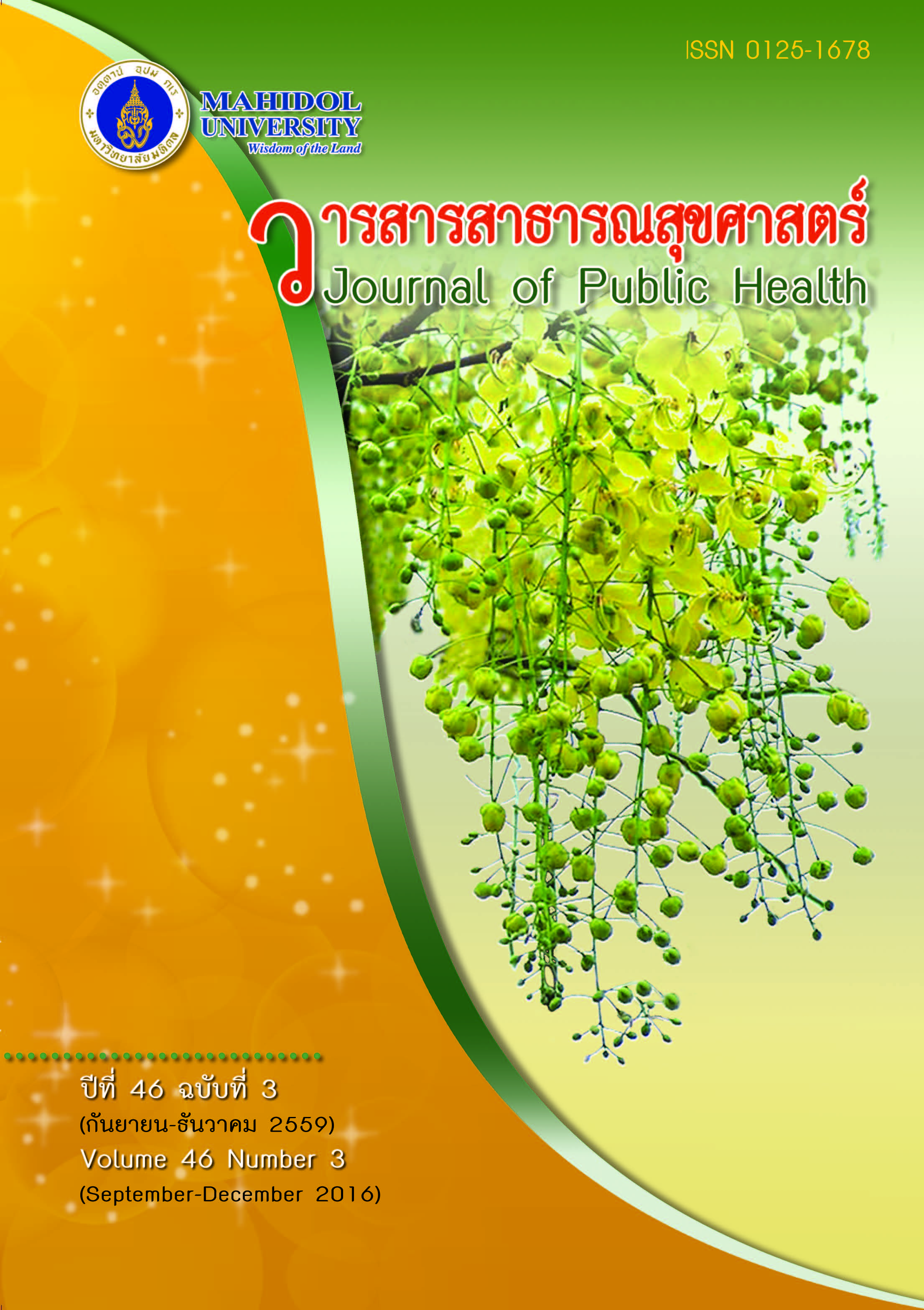ปัจจัยที่มีผลต่อพฤติกรรมเสี่ยงทางเพศของวัยรุ่นหญิง: กรณีศึกษาในนักเรียนหญิงระดับมัธยมศึกษาตอนต้น จังหวัดกาญจนบุรี
Keywords:
ปัจจัยที่มีผลต่อพฤติกรรมเสี่ยงทางเพศ, นักเรียนหญิงชั้นมัธยมศึกษาตอนต้น, factors effecting sexual risk behaviors, female junior high school studentAbstract
การวิจัยเชิงสำรวจนี้ มีวัตถุประสงค์เพื่อศึกษาปัจจัยที่มีผลต่อพฤติกรรมเสี่ยงทางเพศของวัยรุ่นหญิง จังหวัดกาญจนบุรีกลุ่มตัวอย่างเป็นนักเรียนหญิงชั้นมัธยมศึกษาตอนต้น ในโรงเรียนสังกัดสำนักงานเขตพื้นที่การศึกษา จังหวัดกาญจนบุรีจำนวน 345 คน คัดเลือกโดยใช้วิธีการสุ่มตัวอย่างแบบ4 ขั้นตอน(Four stages random sampling) รวบรวมข้อมูลโดยใช้แบบสอบถามที่ผู้วิจัยสร้างขึ้นและผ่านการประเมินความตรงเชิงเนื้อหาและความเที่ยง วิเคราะห์ข้อมูลด้วยสถิติ การแจกแจงความถี่ ร้อยละ ค่าเฉลี่ย ส่วนเบี่ยงเบนมาตรฐาน และการวิเคราะห์การจำแนกพหุ (Multiple Classification Analysis: MCA) ผลการศึกษาพบว่า กลุ่มตัวอย่างส่วนใหญ่มีพฤติกรรมเสี่ยงทางเพศอยู่ในระดับต่ำ (ร้อยละ 98.0) และปัจจัยในแบบจำลองการวิเคราะห์ ได้แก่ ระดับชั้นที่กำลังศึกษา เกรดเฉลี่ยสะสม บุคคลที่นักเรียนพักอาศัยระหว่างเรียน สถานภาพสมรสของพ่อ แม่ กิจกรรมที่ทำในเวลาว่าง ความภาคภูมิใจในตนเอง การเข้าถึงสื่อกระตุ้นอารมณ์ทางเพศ การดูแลเอาใจใส่ของผู้ปกครอง การสื่อสารเพื่อป้องกันการมีพฤติกรรมเสี่ยงทางเพศและอิทธิพลของเพื่อนที่มีต่อพฤติกรรมเสี่ยงทางเพศสามารถร่วมกันทำนายพฤติกรรมเสี่ยงทางเพศของนักเรียนหญิงกลุ่มตัวอย่างได้ ร้อยละ 20.2 (R2=0.202) อย่างมีนัยสำคัญทางสถิติที่ p<0.001 ปัจจัยที่มีความสำคัญ 5 อันดับแรกได้แก่ อิทธิพลของเพื่อน รองลงมาคือ ปัจจัยการเข้าถึงสื่อกระตุ้นอารมณ์ทางเพศ การสื่อสารเพื่อป้องกันการมีพฤติกรรมเสี่ยงทางเพศ สถานภาพสมรสของพ่อ แม่ และระดับชั้นที่กำลังศึกษา ผลการศึกษานี้ชี้ให้เห็นถึงความสำคัญของการนำเพื่อนเข้ามามีส่วนร่วมในกระบวนการเรียนรู้เรื่องเพศ และควรมีการพัฒนาทักษะชีวิตของนักเรียนในการป้องกันการมีเพศสัมพันธุ์เสี่ยงตั้งแต่ชั้นมัธยมศึกษาปีที่ 1
Factors Affecting Sexual Risk Behaviors among Female Adolescents: a Case Study of Female Junior High School Students,Kanchanaburi Province
The objective of this research survey was to study factors affecting sexual risk behaviors of female adolescents. The study subjects were 345 female junior high school students, studying in schools under the educational region of Kanchanaburi Province. The students were recruited using 4 stages of random sampling. Data were collected by self-administered questionnaires developed by the researcher. Frequency, percentage, means, standard deviation, and Multiple Classification Analysis (MCA) were applied to analyze the data. Results of the study revealed that most of the sample students had sexual risk behaviors at low level (98.0%). About 20.0% (R2=0.202) of the variation of sexual risk behaviors could be significantly predicted by factors in the MCA analysis model at p<0.001. The factors comprised class level, grade point average, household members, parents’ marital status, frequently performed free time activities, self-esteem, accessibility to sexually arousing materials and media, parental guidance, effective communication to prevent sexual risk behaviors and the influence of friends in relation to sexual risk behaviors. Moreover, the 5 most important factors consisted of influence of friends followed by accessibility to sexually arousing materials, effective communication, parents’ marital status and class level. Results of the study indicated the importance of involving students’ friends in the sex education learning process. Developing life skills of students in relation to preventing sexual risk behaviors should start at grade 7.
Downloads
Published
Issue
Section
License
Creative Commons License CC-BY-ND


